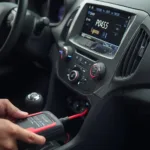The OBD2, or On-Board Diagnostics, port has become a staple in modern vehicles, providing a wealth of information about a car’s health and performance. But did you know that there are different protocols for accessing this data? While most modern cars use the OBD2 standard, older vehicles, particularly heavy-duty trucks and buses, might utilize a different connector and protocol known as SAE-J1708. This article explores the intricacies of the OBD2 to SAE-J1708 connector, its functionality, and how it differs from the standard OBD2 connection.
What is SAE-J1708?
SAE-J1708 is a communication protocol primarily used in heavy-duty vehicles manufactured before 1996. Developed by the Society of Automotive Engineers (SAE), this standard allowed for early onboard diagnostics, primarily focusing on engine performance and emissions. Vehicles equipped with SAE-J1708 often have a 6-pin round connector, distinct from the familiar 16-pin trapezoidal OBD2 connector.
Why the Need for a Connector?
The automotive industry’s transition from SAE-J1708 to OBD2 wasn’t a sudden shift. Many vehicle owners found themselves needing to access diagnostic information from both older and newer vehicles. The OBD2 to SAE-J1708 connector emerged as a solution, bridging the gap between these two protocols. This adapter allows mechanics, fleet managers, and even DIY enthusiasts to use modern OBD2 scanners and software to diagnose and troubleshoot issues in vehicles equipped with the older SAE-J1708 standard.
How Does an OBD2 to SAE-J1708 Connector Work?
The connector itself is relatively simple. On one end, it features a female OBD2 port designed to connect to your standard OBD2 scanner. The other end has a male 6-pin connector that interfaces with the SAE-J1708 port on the vehicle.
Internally, the connector houses a small circuit board that handles the conversion between the two communication protocols. When you connect your OBD2 scanner to the adapter and subsequently to the vehicle, the adapter translates the OBD2 commands from the scanner into SAE-J1708 signals that the vehicle’s onboard computer can understand. Similarly, it translates the diagnostic data received from the vehicle back into OBD2 format, making it readable by your scanner.
Benefits of Using an OBD2 to SAE-J1708 Connector
- Versatility: Diagnose a wider range of vehicles, including those with both OBD2 and SAE-J1708 protocols.
- Cost-Effective: Avoid the need for separate scanners for different vehicle types.
- Convenience: Use your existing OBD2 scanner with older heavy-duty vehicles.
- Access to Valuable Data: Retrieve engine data, fault codes, and other diagnostic information that would otherwise be inaccessible.
Choosing the Right OBD2 to SAE-J1708 Connector
While the core functionality remains consistent, not all OBD2 to SAE-J1708 connectors are created equal. Factors to consider when choosing a connector include build quality, cable length, and compatibility with your specific OBD2 scanner and software. Always opt for reputable brands known for their quality and reliability.
Conclusion
The OBD2 to SAE-J1708 connector plays a crucial role in bridging the gap between older and newer diagnostic systems in the automotive world. Its ability to translate between these protocols allows for continued maintenance and troubleshooting of heavy-duty vehicles manufactured before the widespread adoption of OBD2. By understanding its functionality and choosing the right adapter, you can ensure comprehensive diagnostic coverage for a wider range of vehicles.
FAQs
1. Will this adapter work with my passenger car?
This adapter is primarily designed for heavy-duty vehicles with the SAE-J1708 protocol, commonly found in models manufactured before 1996. Passenger cars typically use the OBD2 standard.
2. Is this adapter compatible with all OBD2 scanners?
While generally compatible with most OBD2 scanners, it’s essential to check the manufacturer’s specifications for your specific scanner to ensure compatibility.
3. Can I use this adapter to clear fault codes in my vehicle?
Yes, depending on your OBD2 scanner’s capabilities and the vehicle’s system, you can typically use this adapter to read and clear fault codes in vehicles with the SAE-J1708 protocol.
4. Where can I find the SAE-J1708 port on my vehicle?
The location can vary, but it’s often found under the dashboard on the driver’s side or near the engine compartment. Consult your vehicle’s owner’s manual for the precise location.
5. Can I leave the adapter connected to my vehicle’s port?
It’s generally not recommended to leave the adapter connected permanently. Disconnect it after each use to prevent potential issues.
For further information and support regarding OBD2 scanners and automotive diagnostics, don’t hesitate to reach out to our expert team. Contact us via WhatsApp: +1(641)206-8880, Email: [email protected]. Our dedicated customer support team is available 24/7 to assist you.
